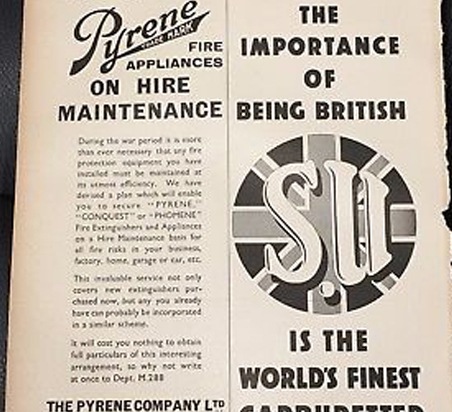The Second World War meant SU had to pause road car carburetter production to help with the war efforts. This change of direction led to SU becoming well known for their aero carburettors and also for the single-point fuel injection pump for the Rolls-Royce Merlin engine.
The SU foray into aeronautical engineering was hugely important to British aviation. During the Battle of Britain, fought in the skies between August and October 1940, the Rolls-Royce Merlin engine in every Spitfire and Hurricane was fuelled by an SU aero carburetter. SU also developed two carburetters for Wolseley powered aircraft.
1934 saw Wolseley Motors advertise a new radial engine called the Aquarius AR7, fitted with an SU AV18 carburetter. At the same time they launched the Aries AR9, fitted with an SU AV20
In 1936 de Havilland developed the Gipsy King, a 405/425hp V12, air-cooled and supercharged aero engine fitted with an SU AV25/ 126 carburetter.
It was 1937 when Rolls-Royce unveiled the Merlin II, the first mass-produced Merlin aero engine, fitted with an SU AVT32/ 135 to be fitted to the Mk1 Hawker Hurricanes and also the Mk1 Vickers Spitfire.
During the late 30s, many manufacturers fitted SU carburetters to their aero engines with the likes of Napier joining the names we have already mentioned.
The Merlin was pushed into active duty when the Second World War began in 1939. The Spitfire and Hurricane aircraft used in the early stages of war had a Rolls-Royce Merlin III engine, developing 1030hp and fitted with an SU AVT 32/135 carburetter.
In 1940, at the request of the Air Ministry, SU increases production of aero carburetters and doubles output to 200 per week. At the same time they increased staff numbers to over 700 to keep up with demand.
In the same year 100-octane fuel becomes available and allows increased boost in the Merlin II and III engines (up to 1310hp). At this time, all Hurricane and Spitfire engines were fitted with the SU AVT35/135 carburetter
As the battle intensified it highlighted a problem with the SU AVT35/ 135 when subject to negative G. A solution to this is developed by Beatrice Shilling, something that would be retrospectively fitted to all aircraft and the new part gained the name of ‘Miss Shilling’s orifice’. See the sub-section on Beatrice Shilling for more information.
In the November of 1940 the SU factory is bombed, suffering enough damage to warrant the creation of a temporary factory in Shirley, Birmingham.
In what was a busy year, SU also developed the AVT40-series of carburetters to cope with the increasing power output delivered by the Merlin engines now fitted with a single-stage, two speed supercharger – a development that allowed greater power at altitude.
In 1941 the Royal Aircraft Establishment developed an anti-G modification for the SU carburetter fitted to the Merlin II and III. The RAE development is retro fitted to many serving aircraft and becomes a standard feature of all new SU carburetters. However, Miss Shilling’s orifice is retained by some aircraft, depending on their role in battle.
1942 saw the launch of the SU 44-series of carburetters, developed for both the Merlin and Griffon engines.
That same year the English Electric Company produces the Napier Sabre, a complex 36.6 litre sleeve-valve aero engine that can produce up to 2400hp. The engines are used successfully in the Hawker Typhoon and Tempest fighters both of which are fitted with SU AVQ-series carburetters.
150-grade fuel is launched in 1944, adding a small amount of tetra-ethyl-led to 100-octane fuel. Using this, the Merlin 63 is capable of withstanding 21lb of boost and 1800hp. This engine is fitted with an SU AVT 44 carburetter as standard.
1944 also sees the launch of an SU single-point fuel injection system for the Rolls-Royce Merlin 100-series engine. Development of the Merlin is undertaken at speed, thanks to the requirements and pressures of war, and some are now capable of up to 2030hp, with 25lb of boost, when using the 150-grade fuel.
Add skinners union logo and design









